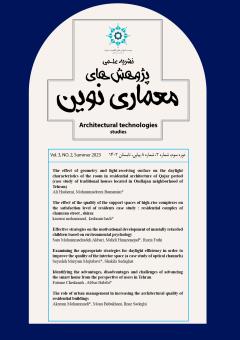-
-
List of Articles
-
Open Access Article
1 - The Effect of Geometry and Light-receiving Surface on the Daylight Characteristics of the Room in Residential Architecture of Qajar Period (Case Study of Traditional Houses Located in Oudlajan Neighborhood of Tehran)
ali hashemi MohammadReza Bemanian -
Open Access Article
2 - The Effect of the Quality of the Support Spaces of High-rise Complexes on the Satisfaction Level of Residents Case Study: Residential Complex of Chamran street, Shiraz
mohammad kazemi Hadi Keshmiri Zeynab Barzegari Jeihoini -
Open Access Article
3 - Effective Strategies for Promoting Motivation in Children with Intellectual Disabilities Based on Environmental Psychology
Sara mohammadzadeh akbari Mahdi hamzenejad Razie Fathi -
Open Access Article
4 - Examining the Appropriate Strategies for Daylight Efficiency in Order to Improve the Quality of the Interior Space (A Case Study of Optical Channels)
Seyedeh Maryam Mojtabavi Shakila Sedaghat -
Open Access Article
5 - Identifying the Advantages, Disadvantages and Challenges of Advancing the Smart Home from the Perspective of Users in Tehran
Fatemeh Cheshmeh عباس حبیبی -
Open Access Article
6 - The Role of Urban Management in Increasing the Architectural Quality of Residential Buildings
akram mohammadi mona babakhani ilnaz sadeghi
-
The rights to this website are owned by the Raimag Press Management System.
Copyright © 2017-2025







